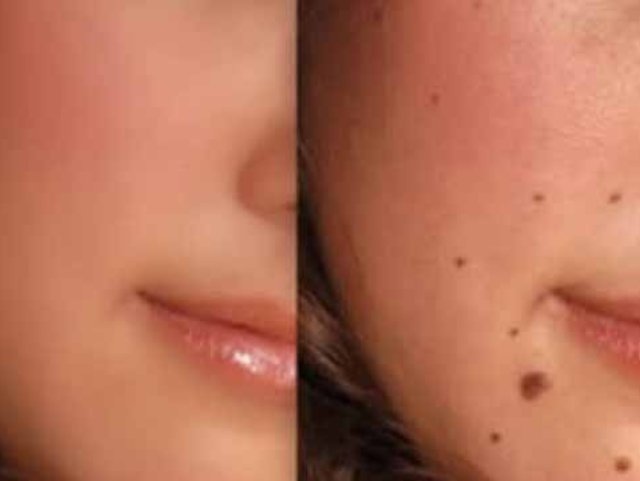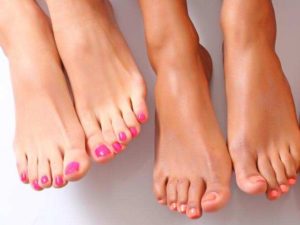1 in 10 babies are born with birthmarks. Contrary to popular belief, birthmarks are not just brown or black, but can be red, pink, white, blue, purple, yellow or even hairy! Most birthmarks are present at birth, but some appear a few months after birth, or even at puberty. Most birthmarks stay with you for life, while some fade away or completely disappear.Which ones are best left alone? And which birthmarks need to be treated or removed?
Birthmarks are a lot more common than we think. They are not the same as moles (those little black dots on your skin), which affect each and every one of us, and which appear later in life. I’m a “birthmark baby” myself, and have come to realize that there are a lot of myths and tales associated with birthmarks. Some pink birthmarks on the nape of the neck are known as “stork bites”. Birthmarks on the nose or between the eyes mean that the baby is “kissed by an angel”. Unusual looking birthmarks like white streaks on the body or facial birthmarks are viewed as lucky omens. On the other hand, large unsightly black birthmarks covering large areas of the body are supposed to indicate that the poor baby is “marked by the devil”! Irrespective of the kind of birthmark your baby has, it is wise to get it seen by a dermatologist for proper diagnosis and prognosis. Please remember that all birthmarks are just a quirk of nature. It is not a disease or a malformation. So do not blame yourself for your child’s birthmark as there is nothing you could have done to prevent them.
Birthmarks can be pigmented (black, brown or blue), white, skin colored, or vascular (red, pink and purple birthmarks formed out of blood vessels). I shall only cover the commonly occurring birthmarks. The medical term for a birthmark is ‘Nevus’.
Black, raised moles which appear at birth or infancy are known as Congenital Melanocytic Nevus. Cindy Crawford’s upper lip mole comes to mind. They can appear as a single mole or multiple satellite moles of varying sizes. They might grow slightly larger or darker with age, and some may sprout thick hair. Unless you have a large mole (more than 2 cm in diameter) or more than 20 such moles, they are usually not a cause for concern. If you are very fair skinned, and your mole is over an exposed part of your body (head and neck, forearms etc), then you must protect your mole from the sun, by using a sunscreen. If you have a history of skin cancer in yourself or in your family, then get an annual mole check done by your dermatologist. Your doctor will measure your mole, photograph it and examine it with a special microscope called the dermatoscope, and maintain a record in your file. Any change in the size, shape or color of the mole, must be reported to the dermatologist. If your mole starts to itch, bleed, ulcerate or form lumps beneath, then visit your doctor without delay. Such moles can be removed purely for cosmetic reasons as well. It is best to get them removed by a plastic surgeon, but do know that you’ll be left with a scar. As a rule, all excised moles are sent to the lab for microscopic examination. Lasers have also been tried to lighten these moles, but theoretically speaking, these moles must never be disturbed with lasers, as the laser excites the pigment cells and can trigger a cancerous transformation.
A large dark blue to purplish birthmark appearing around the eye is known as the Nevus of Ota. Sometimes the pigment may also affect the white of the eye. These birthmarks can either appear at birth or later in life. The pigment is usually very deep seated, and skin lightening creams are worthless as a choice of treatment. Laser treatment gives good results after multiple sessions. Camouflage make-up can be used to temporarily cover up the birthmark. They are inexpensive and make a world of difference to one’s self esteem. A regular eye check up is advised, if the eye is affected.
Mongolian spots are bluish spots seen on the lower back or buttocks of newborns. They are more common in darker skinned babies. Although they are “marks that appear at birth”, they are not considered as Nevus in the medical sense. They are completely harmless and fade away on their own in a few years. These are best left alone.
Becker’s Nevus is a large, irregular, flat, brown-to-black birthmark which only appears after puberty, and is usually located on the chest or shoulders. It is more common in boys, and the mole is usually hairier than the surrounding skin. They are usually harmless, but they remain for life. Lasers have been tried to lighten the pigmentation and get rid of the excess hair, but the treatments are painful, and the results can be disappointing. They are perhaps, best left alone.
Café au lait birthmarks are small oval flat light brown spots which can appear anywhere on the body. They are harmless, do not grow in size and stay for life. They may turn a touch darker after puberty. Unless your baby has more than 6 café au lait spots which measure more than 1.5cm in diameter, they are not a cause for concern. If a café au lait macule is large and has several dotted brown-black spots on it, then it’s called a Nevus Spilus.
Nevus achromicus is a pale, off-white birthmark which can appear in any part of the body. They may appear as isolated birthmarks or streaky lines. They are completely harmless, do not grow larger in size, do not change color but stay for life. They are best left alone, as there is no treatment for this kind of birthmark. Use sunscreens, as skin tanning might make these birthmarks appear more prominent, as the birthmark itself never tans. Camouflage make-up/foundations can be used to temporary hide the area.
Intradermal Nevus are skin colored, raised bumps measuring 5-10mm, which can appear anywhere on the body. They usually appear in late childhood or early adulthood. Sarah Jessica Parker’s chin mole is a good example. Although they stay for life, they can be left alone, as these moles are considered harmless, and never turn cancerous.
A salmon patch birthmark is a pale pink-orange birthmark which is seen at birth, usually on the face or the back of the neck. They may appear darker when the baby cries, and will seem to disappear if you press a thumb on it. They are harmless and must be left alone, as most of the time this type of birthmark disappears on its own in 3-4 years.
A port wine stain appears at birth as a flat, pinkish-red stain, most likely seen on the face. They may get darker (purplish), larger or thicker with time. Mikhail Gorbachev’s forehead stain is one such birthmark. If the birthmark is over the eyelids, then an ophthalmological evaluation is advised. A port wine stain stays for life. It is usually harmless, but must always be shown to a dermatologist, as rarely they can be associated with seizures or limb deformity. These birthmarks can be left alone, but if your child asks for treatment, then laser therapy is your best bet.
There are many more different types of birthmarks, which are rarer and beyond the scope of a public information article. Birthmark removals are rarely doctor-recommended. Most patients chose to get rid of their birthmark for cosmetic reasons alone, and that’s a personal choice. If you chose to have them surgically removed, then you will be left with a scar, so you’ll have to choose one aesthetic defect over the other. Lasers are expensive and may not work for all types of birthmarks. If you are a “birthmark parent”, then being supportive is the greatest service you can do for your child. Facial birthmarks in particular, can cause a great deal of social inhibition and emotional turmoil, especially during the teen years. I have never used camouflage make up to hide the café au lait spot on my nose. And it is my personal recommendation that you do not force your child to use cover-up foundation, or undergo laser surgery, unless they themselves ask for it. Finally, any kind of birthmark must be assessed by a dermatologist at the earliest.




